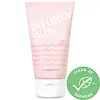What's inside
What's inside
 Key Ingredients
Key Ingredients

 Benefits
Benefits

 Concerns
Concerns

 Ingredients Side-by-side
Ingredients Side-by-side

Water
Skin ConditioningGlycerin
HumectantCoco-Caprylate/Caprate
EmollientSorbitan Stearate
EmulsifyingGlyceryl Stearate Se
EmulsifyingCetearyl Alcohol
EmollientTriheptanoin
Skin ConditioningSodium Acrylate/Sodium Acryloyldimethyl Taurate Copolymer
Emulsion StabilisingCetyl Alcohol
EmollientSilica
AbrasiveSqualane
EmollientVitis Vinifera Seed Oil
EmollientPalmitoyl Grapevine Shoot Extract
AntioxidantC15-19 Alkane
SolventGlycolic Acid
BufferingBisabolol
MaskingBenzyl Alcohol
PerfumingSodium Hydroxide
BufferingCitric Acid
BufferingCaprylyl Glycol
EmollientLactic Acid
BufferingXanthan Gum
EmulsifyingPolyglyceryl-6 Laurate
EmulsifyingArginine
MaskingPaeonia Lactiflora Root Extract
Skin ConditioningTartaric Acid
BufferingPolyglycerin-6
HumectantHelianthus Annuus Seed Oil
EmollientTocopherol
AntioxidantSorbitan Oleate
EmulsifyingGlucose
HumectantDehydroacetic Acid
PreservativeSorbitan Isostearate
EmulsifyingAcer Saccharum Extract
Skin ConditioningCarbomer
Emulsion StabilisingSodium Phytate
Papain
Skin Conditioning1,2-Hexanediol
Skin ConditioningAlgin
MaskingCitrus Limon Peel Oil
MaskingParfum
MaskingWater, Glycerin, Coco-Caprylate/Caprate, Sorbitan Stearate, Glyceryl Stearate Se, Cetearyl Alcohol, Triheptanoin, Sodium Acrylate/Sodium Acryloyldimethyl Taurate Copolymer, Cetyl Alcohol, Silica, Squalane, Vitis Vinifera Seed Oil, Palmitoyl Grapevine Shoot Extract, C15-19 Alkane, Glycolic Acid, Bisabolol, Benzyl Alcohol, Sodium Hydroxide, Citric Acid, Caprylyl Glycol, Lactic Acid, Xanthan Gum, Polyglyceryl-6 Laurate, Arginine, Paeonia Lactiflora Root Extract, Tartaric Acid, Polyglycerin-6, Helianthus Annuus Seed Oil, Tocopherol, Sorbitan Oleate, Glucose, Dehydroacetic Acid, Sorbitan Isostearate, Acer Saccharum Extract, Carbomer, Sodium Phytate, Papain, 1,2-Hexanediol, Algin, Citrus Limon Peel Oil, Parfum
Water
Skin ConditioningGlycerin
HumectantCellulose
AbsorbentButylene Glycol
HumectantAlcohol Denat.
AntimicrobialDipropylene Glycol
HumectantPentylene Glycol
Skin ConditioningCeteareth-12
EmulsifyingCitrus Limon Peel Oil
MaskingJuniperus Mexicana Oil
MaskingCitrus Aurantium Dulcis Peel Oil
MaskingCitrus Grandis Peel Oil
MaskingEucalyptus Globulus Leaf Oil
PerfumingLavandula Angustifolia Oil
MaskingRosmarinus Officinalis Leaf Oil
MaskingAloe Barbadensis Leaf Polysaccharides
EmollientPhoenix Dactylifera Seed
Skin Conditioning1,2-Hexanediol
Skin ConditioningTriethanolamine
BufferingPolysorbate 20
EmulsifyingCaprylyl Glycol
EmollientLactose
HumectantHydroxypropyl Methylcellulose
Emulsion StabilisingEthylhexylglycerin
Skin ConditioningJojoba Esters
EmollientHydrogenated Lecithin
EmulsifyingMannitol
HumectantAscorbyl Palmitate
AntioxidantTocopheryl Acetate
AntioxidantCholesterol
EmollientPEG-800
HumectantBromelain
Skin ConditioningPapain
Skin ConditioningAscorbic Acid
AntioxidantSh-Oligopeptide-1
Skin ConditioningSh-Polypeptide-1
Skin ConditioningSh-Oligopeptide-2
Skin ConditioningSh-Polypeptide-22
Skin ConditioningSh-Polypeptide-45
Skin ConditioningSh-Polypeptide-8
HumectantSh-Polypeptide-9
Skin ConditioningCarbomer
Emulsion StabilisingDisodium EDTA
CI 77007
Cosmetic ColorantWater, Glycerin, Cellulose, Butylene Glycol, Alcohol Denat., Dipropylene Glycol, Pentylene Glycol, Ceteareth-12, Citrus Limon Peel Oil, Juniperus Mexicana Oil, Citrus Aurantium Dulcis Peel Oil, Citrus Grandis Peel Oil, Eucalyptus Globulus Leaf Oil, Lavandula Angustifolia Oil, Rosmarinus Officinalis Leaf Oil, Aloe Barbadensis Leaf Polysaccharides, Phoenix Dactylifera Seed, 1,2-Hexanediol, Triethanolamine, Polysorbate 20, Caprylyl Glycol, Lactose, Hydroxypropyl Methylcellulose, Ethylhexylglycerin, Jojoba Esters, Hydrogenated Lecithin, Mannitol, Ascorbyl Palmitate, Tocopheryl Acetate, Cholesterol, PEG-800, Bromelain, Papain, Ascorbic Acid, Sh-Oligopeptide-1, Sh-Polypeptide-1, Sh-Oligopeptide-2, Sh-Polypeptide-22, Sh-Polypeptide-45, Sh-Polypeptide-8, Sh-Polypeptide-9, Carbomer, Disodium EDTA, CI 77007
 Reviews
Reviews

Ingredients Explained
These ingredients are found in both products.
Ingredients higher up in an ingredient list are typically present in a larger amount.
1,2-Hexanediol is a synthetic liquid and another multi-functional powerhouse.
It is a:
- Humectant, drawing moisture into the skin
- Emollient, helping to soften skin
- Solvent, dispersing and stabilizing formulas
- Preservative booster, enhancing the antimicrobial activity of other preservatives
Caprylyl Glycol is a humectant and emollient, meaning it attracts and preserves moisture.
It is a common ingredient in many products, especially those designed to hydrate skin. The primary benefits are retaining moisture, skin softening, and promoting a healthy skin barrier.
Though Caprylyl Glycol is an alcohol derived from fatty acids, it is not the kind that can dry out skin.
This ingredient is also used as a preservative to extend the life of products. It has slight antimicrobial properties.
Learn more about Caprylyl GlycolCarbomer is a polymer of acrylic acid. Its main role is to create a gel consistency.
A high amount of carbomer can cause pilling or balling up of products. Don't worry, most products contain 1% or less of carbomer.
Citrus Limon Peel Oil is created from the peels of the lemon. It is used to add a lemon-scent to products. Lemon peel oil also has antibacterial, antifungal, and antioxidant properties. However, it may also cause phototoxicity and sensitize skin.
Lemon peel oil contains limonene, a skin sensitizing ingredient. Another component is furanocoumarin, which induces phototoxicity in skin.
Furanocoumarins bind and destabilize your DNA to increase the rate of sunburn.
Most reputable companies will remove furanocoumarins from their formulations.
Learn more about Citrus Limon Peel OilGlycerin is already naturally found in your skin. It helps moisturize and protect your skin.
A study from 2016 found glycerin to be more effective as a humectant than AHAs and hyaluronic acid.
As a humectant, it helps the skin stay hydrated by pulling moisture to your skin. The low molecular weight of glycerin allows it to pull moisture into the deeper layers of your skin.
Hydrated skin improves your skin barrier; Your skin barrier helps protect against irritants and bacteria.
Glycerin has also been found to have antimicrobial and antiviral properties. Due to these properties, glycerin is often used in wound and burn treatments.
In cosmetics, glycerin is usually derived from plants such as soybean or palm. However, it can also be sourced from animals, such as tallow or animal fat.
This ingredient is organic, colorless, odorless, and non-toxic.
Glycerin is the name for this ingredient in American English. British English uses Glycerol/Glycerine.
Learn more about GlycerinPapain is an enzyme found naturally in the papaya plant's leaves, fruit, and roots. It has antimicrobial, soothing, and wound healing properties.
Glycine and Vitamin A are naturally found in papain.
While papain is often touted as skin-lightening, further studies are needed to prove this. However, papain has been shown to help soothe acne-inflammation.
Papain belongs to a class of enzymes called proteolytic enzymes. These enzymes break down peptides and amino acids.
Some studies found papain to be a potential skin sensitizer and allergen. Those with latex allergies might also be allergic to papaya.
Learn more about PapainWater. It's the most common cosmetic ingredient of all. You'll usually see it at the top of ingredient lists, meaning that it makes up the largest part of the product.
So why is it so popular? Water most often acts as a solvent - this means that it helps dissolve other ingredients into the formulation.
You'll also recognize water as that liquid we all need to stay alive. If you see this, drink a glass of water. Stay hydrated!
Learn more about Water